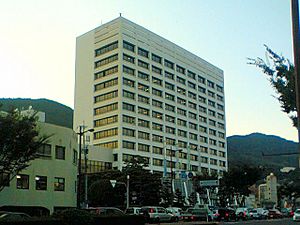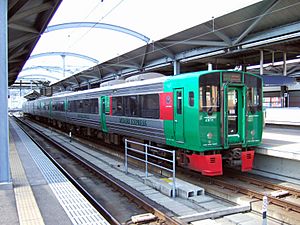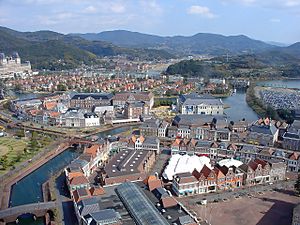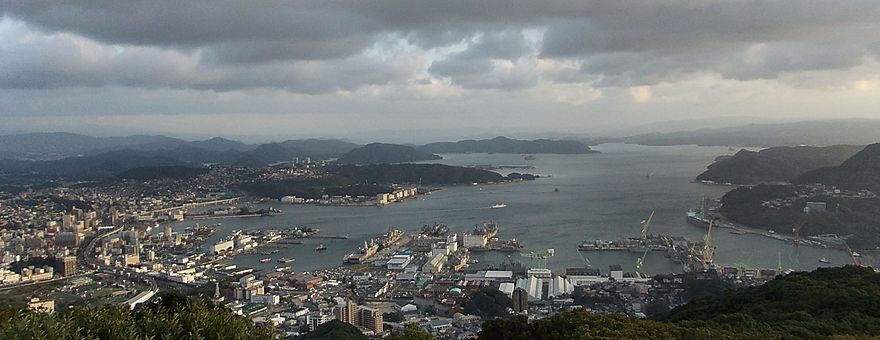Sasebo facts for kids
Quick facts for kids
Sasebo
佐世保市
|
|||||||||||
|---|---|---|---|---|---|---|---|---|---|---|---|
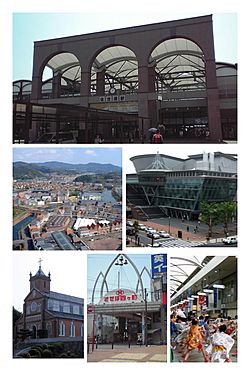
Sasebo Station, Huis Ten Bosch, Arkas Sasebo, Kuroshima Church, Sasebo Yonkacho, Yosakoi Sasebo Matsuri
|
|||||||||||
|
|||||||||||
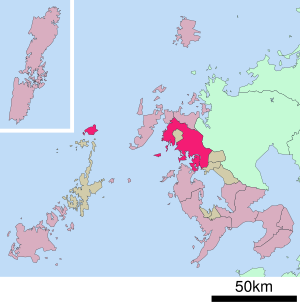
Location of Sasebo in Nagasaki Prefecture
|
|||||||||||
| Country | Japan | ||||||||||
| Region | Kyushu | ||||||||||
| Prefecture | Nagasaki Prefecture | ||||||||||
| Area | |||||||||||
| • Total | 426.06 km2 (164.50 sq mi) | ||||||||||
| Population
(2020)
|
|||||||||||
| • Total | 243,223 | ||||||||||
| • Density | 570.866/km2 (1,478.535/sq mi) | ||||||||||
| Time zone | UTC+09:00 (JST) | ||||||||||
| City hall address | 1–10 Hachiman, Sasebo-shi, Nagasaki-ken 857-8585 |
||||||||||
| Climate | Cfa | ||||||||||
|
|||||||||||
Sasebo (佐世保市, Sasebo-shi) is a core city located in Nagasaki Prefecture, Japan. It is also the second largest city in Nagasaki Prefecture, after its capital, Nagasaki. On 1 June 2019, the city had an estimated population of 247,739 and a population density of 581 persons per km2 (1,505 persons per square mile). The total area is 426.06 km2 (165 sq mi).
The city includes a part of Saikai National Park. Located in the southern part of the city is the Dutch-styled theme park Huis Ten Bosch. The island of Ukujima is also administered as part of Sasebo city.
Contents
History
The area of present-day Sasebo was a small fishing village under the control of nearby Hirado Domain until shortly after the start of the Meiji period. Imperial Japanese Navy Admiral Tōgō Heihachirō, when surveying the coasts of northwestern Kyūshū for the site of a navy base, selected his location based on its protected, deep-water harbor, geographic proximity to China and Korea, and the presence of nearby coal fields. Sasebo Naval District, founded in 1886, became the major port for the Japanese navy in its operations in the First Sino-Japanese War and Russo-Japanese War, and remained a major naval base to the end of World War II. Along with the base facilities, the navy also constructed the Sasebo Naval Arsenal, which included major shipyards and repair facilities.
Sasebo City was founded on April 1, 1902. The city which had 206,000 inhabitants in 1945 suffered severe damage by bombing on June 29, 1945, during World War II. 48% of the city was destroyed. Sasebo was one of the original 17 targets selected for the dropping of the atomic bomb.
After the end of the war, part of the base facilities were taken over by the United States Navy, forming U.S. Fleet Activities Sasebo. Some parts of the base are shared with the Japan Self-Defense Forces, in particular the JMSDF, though the primary base of the JGSDF's Western Army Infantry Regiment is also among the facilities there.
Mergers
- On April 1, 2005, the towns of Sechibaru and Yoshii (both from Kitamatsuura District) were merged into Sasebo.
- On March 31, 2006, the towns of Kosaza and Uku (both from Kitamatsuura District) were merged into Sasebo.
- On March 31, 2010, the towns of Emukae and Shikamachi (both from Kitamatsuura District) were merged into Sasebo.
Economy
Shipbuilding and associated heavy industries continue to dominate the economy of Sasebo. Adjacent to the naval base is the Sasebo Heavy Industries Co., Ltd. shipyard. The Port of Sasebo has an active fishing fleet, and many oyster and pearl farms are located on the Kujū-ku Islands.
The Mikawachi district has a 400-year-old pottery manufacturing industry.
Sasebo Station is the westernmost station in the JR passenger train system and is about two hours by train from Hakata Station in the city of Fukuoka (via the Midori line) and about an hour and half from Nagasaki Station in the city of Nagasaki. Across the street from Sasebo Station is the Sasebo Bus Center, which provides connecting service to many local destinations.
Geography
Climate
The climate is similar to that of Norfolk, Virginia. Rainy season lasts from early June to mid-July, and the summer is hot and humid. During the winter, there may be light snowfall and some freezing.
According to the Japan Meteorological Agency (JMA), Sasebo has a humid subtropical climate (Köppen climate classification Cfa) with hot summers and cool winters. Precipitation is significant throughout the year, but is somewhat lower in winter.
| Climate data for Sasebo (1991–2020 normals, extremes 1946–present) | |||||||||||||
|---|---|---|---|---|---|---|---|---|---|---|---|---|---|
| Month | Jan | Feb | Mar | Apr | May | Jun | Jul | Aug | Sep | Oct | Nov | Dec | Year |
| Record high °C (°F) | 20.3 (68.5) |
22.4 (72.3) |
24.8 (76.6) |
28.4 (83.1) |
31.7 (89.1) |
36.2 (97.2) |
37.6 (99.7) |
38.0 (100.4) |
35.2 (95.4) |
33.0 (91.4) |
27.2 (81.0) |
23.9 (75.0) |
38.0 (100.4) |
| Average high °C (°F) | 10.5 (50.9) |
11.7 (53.1) |
15.1 (59.2) |
19.6 (67.3) |
23.8 (74.8) |
26.5 (79.7) |
30.1 (86.2) |
31.8 (89.2) |
28.7 (83.7) |
24.0 (75.2) |
18.5 (65.3) |
12.9 (55.2) |
21.1 (70.0) |
| Daily mean °C (°F) | 7.0 (44.6) |
7.8 (46.0) |
11.0 (51.8) |
15.3 (59.5) |
19.7 (67.5) |
23.0 (73.4) |
26.8 (80.2) |
28.0 (82.4) |
24.8 (76.6) |
20.0 (68.0) |
14.4 (57.9) |
9.2 (48.6) |
17.3 (63.0) |
| Average low °C (°F) | 3.6 (38.5) |
4.1 (39.4) |
7.2 (45.0) |
11.3 (52.3) |
15.8 (60.4) |
20.0 (68.0) |
24.4 (75.9) |
25.2 (77.4) |
21.8 (71.2) |
16.4 (61.5) |
10.5 (50.9) |
5.7 (42.3) |
13.8 (56.9) |
| Record low °C (°F) | −4.9 (23.2) |
−6.1 (21.0) |
−3.9 (25.0) |
−0.4 (31.3) |
5.7 (42.3) |
11.6 (52.9) |
14.2 (57.6) |
17.1 (62.8) |
10.0 (50.0) |
4.8 (40.6) |
0.4 (32.7) |
−3.3 (26.1) |
−6.1 (21.0) |
| Average precipitation mm (inches) | 63.4 (2.50) |
81.1 (3.19) |
120.7 (4.75) |
152.9 (6.02) |
171.1 (6.74) |
328.9 (12.95) |
342.2 (13.47) |
255.4 (10.06) |
195.6 (7.70) |
98.6 (3.88) |
101.6 (4.00) |
77.5 (3.05) |
1,989 (78.31) |
| Average snowfall cm (inches) | 1 (0.4) |
trace | 0 (0) |
0 (0) |
0 (0) |
0 (0) |
0 (0) |
0 (0) |
0 (0) |
0 (0) |
0 (0) |
0 (0) |
1 (0.4) |
| Average precipitation days (≥ 1.0 mm) | 8.1 | 8.1 | 9.9 | 8.9 | 8.8 | 12.3 | 11.3 | 10.2 | 9.1 | 6.2 | 7.7 | 7.4 | 108 |
| Average snowy days (≥ 1 cm) | 0.3 | 0.1 | 0 | 0 | 0 | 0 | 0 | 0 | 0 | 0 | 0 | 0 | 0.4 |
| Average relative humidity (%) | 63 | 62 | 63 | 66 | 70 | 78 | 79 | 76 | 71 | 65 | 66 | 62 | 68 |
| Mean monthly sunshine hours | 111.5 | 128.2 | 167.2 | 183.2 | 197.2 | 128.2 | 165.6 | 209.0 | 177.6 | 188.6 | 142.1 | 122.0 | 1,922.9 |
| Source: Japan Meteorological Agency | |||||||||||||
Demographics
Per Japanese census data, the population of Sasebo in 2020 is 243,223 people. Sasebo has been conducting censuses since 1920.
| Historical population | ||
|---|---|---|
| Year | Pop. | ±% |
| 1920 | 183,601 | — |
| 1925 | 196,391 | +7.0% |
| 1930 | 228,039 | +16.1% |
| 1935 | 277,451 | +21.7% |
| 1940 | 312,817 | +12.7% |
| 1945 | 281,555 | −10.0% |
| 1950 | 313,259 | +11.3% |
| 1955 | 351,820 | +12.3% |
| 1960 | 346,598 | −1.5% |
| 1965 | 302,431 | −12.7% |
| 1970 | 287,936 | −4.8% |
| 1975 | 288,368 | +0.2% |
| 1980 | 288,231 | −0.0% |
| 1985 | 287,349 | −0.3% |
| 1990 | 280,261 | −2.5% |
| 1995 | 279,551 | −0.3% |
| 2000 | 274,399 | −1.8% |
| 2005 | 269,574 | −1.8% |
| 2010 | 261,146 | −3.1% |
| 2015 | 255,439 | −2.2% |
| 2020 | 243,223 | −4.8% |
| Sasebo population statistics | ||
Transportation
The nearest airport is Nagasaki Airport in the city of Ōmura. The Kyushu Railway Company (JR Kyushu) provides rail transportation on the Sasebo Line, whose terminal is at Sasebo Station. The daily Midori Express provides transportation to/from Fukuoka's Hakata Station. Bus service to the Fukuoka Airport is also available from the Sasebo Bus Center. Three national highways crisscross the city: Route 35, 204, and 498.
Mayors of Sasebo (from 1902)
| Nº | Name | Term start | Term end |
|---|---|---|---|
| 1 | Osamu Watanabe (渡邊修) |
6 September 1902 | 27 April 1906 |
| 2–3 | Masahiko Uchida (内田政彦) |
27 August 1906 | 3 September 1916 |
| 4 | Hachitaro Kato (加藤八太郎) |
14 October 1916 | 13 October 1920 |
| 5 | Keitaro Ojima (筬島桂太郎) |
12 August 1921 | 11 August 1925 |
| 6 | Terusato Aiga (相賀照郷) |
29 June 1926 | 28 June 1930 |
| 7 | Norizo Mikuriya (御厨規三) |
10 October 1930 | 9 September 1934 |
| 8–9 | Tetrusato Aiga | 7 November 1934 | 29 April 1940 |
| 10–11 | Sohei Koura (小浦総平) |
5 August 1940 | 5 May 1946 |
| 12–14 | Masasuke Nakata (中田正輔) |
21 August 1946 | 2 April 1955 |
| 15–16 | Tatsushiro Yamanaka (山中辰四郎) |
30 April 1955 | 29 April 1963 |
| 17–20 | Ichiro Tsuji (辻一三) |
30 April 1963 | 29 April 1979 |
| 21–24 | Kumashi Kakehashi (桟熊獅) |
30 April 1979 | 29 April 1995 |
| 25–27 | Akira Mitsutake (光武顕) |
30 April 1995 | 29 April 2007 |
| 28–31 | Norio Tomonaga (朝長則男) |
30 April 2007 | Incumbent |
Points of interest
- Hirado, to the north, was a foreign trade port and where William Adams is buried (James Clavell based his novel Shōgun (1975) on Adams' life)
- Huis Ten Bosch (theme park), inspired by a Dutch trading post in nearby Hirado
- Japan Maritime Self-Defense Force Museum
- Kōzakihana, westernmost point on the island of Kyūshū
- Kujū-ku Islands
- Miuramachi Catholic Church, a large church which was built in a neogothic style in 1930, is the symbol of Sasebo. It is opposite the main railway station in Miura-cho district. Sasebo is the only Japanese city which uses the symbol of a Christian church as part of its seal/flag.
- Saikai Pearl Sea Resort
- Sasebo Zoological Park and Botanical Garden
- Tenkaihō
- Ureshino, to the south, has hot springs resorts
Cityscape
Sister city relations
Sasebo has sister-city relations with three places outside Japan and one within the country:
 Albuquerque, New Mexico, United States
Albuquerque, New Mexico, United States Coffs Harbour, New South Wales, Australia
Coffs Harbour, New South Wales, Australia Xiamen, Fujian, China
Xiamen, Fujian, China Kokonoe, Ōita
Kokonoe, Ōita
See also
 In Spanish: Sasebo para niños
In Spanish: Sasebo para niños





